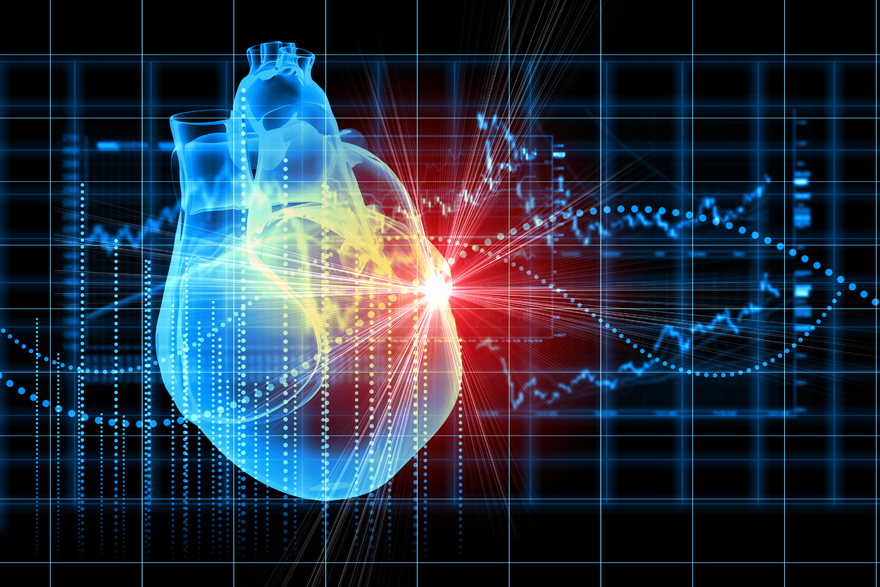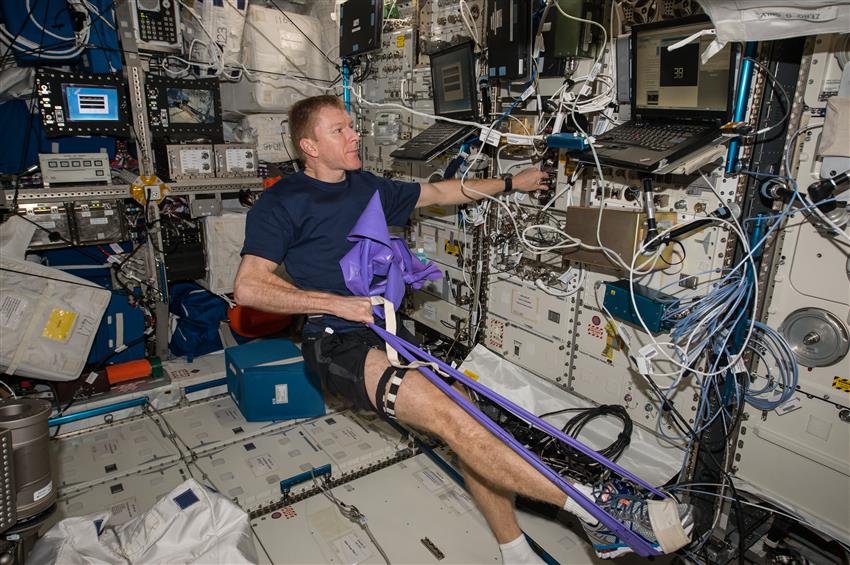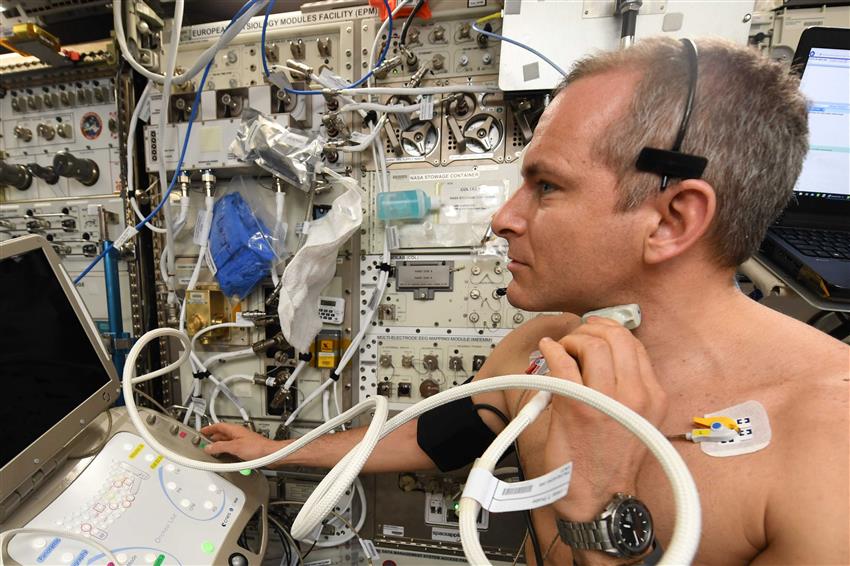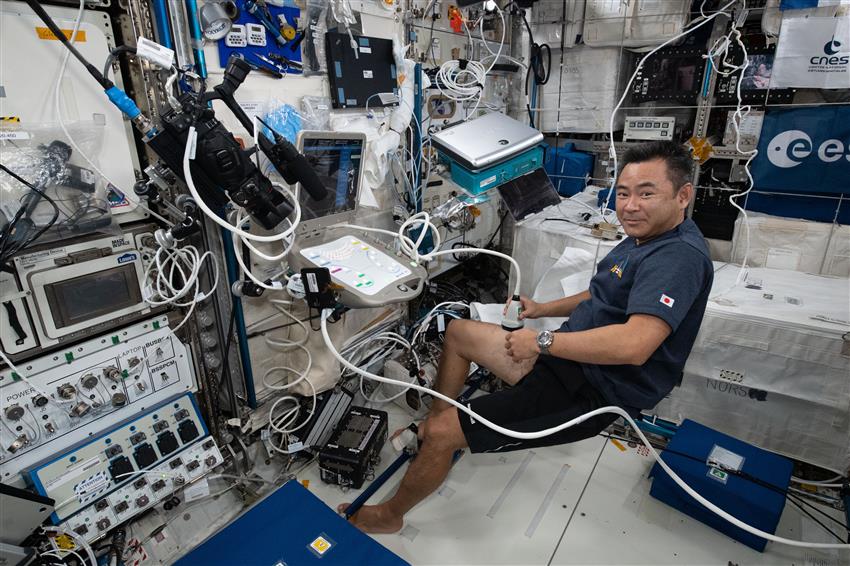The Vascular series: Studying heart health in space
The Vascular series groups four Canadian science experiments: Vascular, Vascular Echo, Vascular Aging, and Vascular Calcium. It studies the effects of weightlessness on astronauts' blood vessels and hearts on board the International Space Station (ISS).
Background
Our cardiovascular system has evolved to suit life on Earth. The heart pumps blood through the arteries, providing oxygen to our cells throughout the body. The absence of gravity in space disturbs this system.
Astronauts do not have to work as hard to move around the Station. An earlier Canadian study called Cardiovascular and Cerebrovascular Control on Return from the International Space Station (CCISS) confirmed that weightlessness on the Station greatly reduces level of physical activity and heart rate.
To deepen our understanding of the effects of microgravity on the cardiovascular system, the Vascular and Vascular Echo studies used blood tests and ultrasound technology to examine astronauts' blood vessels.
Vascular Aging and Vascular Calcium are looking at other issues known to pose risks to astronauts' health, like radiation and insulin resistance, a precursor of Type 2 diabetes. Vascular Calcium, in particular, will use 3D and other types of imaging on astronauts to see if calcium is lost from bones and builds up on the walls of major arteries during long space flights.
Studying the responses of the cardiovascular system in space better equips us to understand how our arteries age here on Earth.
During a six-month space mission, an astronaut's cardiovascular system can age by up to 10 or 20 years. European Space Agency (ESA) astronaut Tim Peake took part in the Canadian experiment Vascular Echo aboard the ISS to examine changes in heart and blood vessels of astronauts in space. (Credits: Canadian Space Agency [CSA], NASA)
Objectives
Each of the Vascular studies looks more closely at heart health in space to:
- Vascular
- track changes in blood vessels and monitoring heart function
- observe how arteries react to changes in blood pressure and to reduced physical activity
- measure blood markers related to expected vascular changes
- Vascular Echo
- observe how arteries and the heart react to changes in blood pressure
- evaluate the efficiency of a countermeasure by testing whether a leg cuff can reduce the excess amount of blood in the upper body
- determine whether blood flow after exercise is changed by space flight
- associate certain warning signs in the blood with early arterial stiffness
- find an easier, less invasive way than ultrasound to measure changes in arterial elasticity
- learn more about recovery up to one year upon the astronauts' return
- Vascular Aging
- identify the specific cause of increased arterial stiffness in astronauts
- confirm if and when insulin resistance develops during a space mission
- clarify the effect of radiation exposure on cardiovascular health
- track the recovery process after return
- Vascular Calcium
- determine if one year in space increases the arterial stiffness and insulin resistance observed in six-month space flights (as part of NASA's CIPHER program)
- ascertain whether one-year missions promote calcium loss from bones and accumulation in arteries
- determine if changes in physical activity and fitness relate to changes in insulin resistance
- help establish the potential cardiovascular and bone health risks of very long space flights
Impacts on Earth
Cardiovascular disease is the number one cause of death on Earth. According to the Heart and Stroke Foundation, 9 out of 10 Canadians have at least one risk factor for heart disease or stroke, including lack of physical activity.
Vascular's results suggest that a daily session of aerobic (cardio) exercise alone is not sufficient to counteract the effects of an otherwise sedentary lifestyle.

Arterial stiffness, a condition that occurs when arteries become less elastic, influences how hard the heart has to work to pump blood through the body. Stiffening of the arteries can increase the risk of cardiovascular events like heart attacks and strokes.
Vascular Calcium is one of two CSA studies that are part of the CIPHER program. The other is TBone2.
CIPHER, which stands for Complement of Integrated Protocols for Human Exploration Research, is a NASA program brings together specially selected studies to be conducted on the ISS. CIPHER is designed to help better understand the impact of long-duration space flight by comparing the effects of different mission lengths: short stays, standard six-month missions, and long-duration (one-year) space flights.
How it works
-
Vascular
Nine astronauts took part in this study.- The participants underwent blood tests before, during, and after their missions to collect information that can be linked to other recorded effects.
- Researchers took ultrasound images before the astronauts' departures to measure the elasticity of their arteries, and compared the images to others taken upon return.
-
Vascular Echo
Nine astronauts participated in this study.- The participants underwent blood tests before, during, and after their missions.
- Resting ultrasound imaging was performed before, during, and after the flight.
- The participants did simple exercises during spaceflight while an ultrasound device, strapped to their thigh, measured changes in blood flow.
- Astronauts wore an inflatable cuff that monitors blood pressure. Its results were compared to the ultrasound data to determine if blood pressure can be used as a more efficient indicator of arterial change.
-
Vascular Aging
Nine astronauts are participating in this study.- Astronauts undergo blood tests before, during, and after space flight.
- Resting ultrasound scans of the head, neck, torso, arms, and legs are taken before, during, and after the mission.
- Astronauts wear a Bio-Monitor smart shirt, which monitors their heart rate, activity level, and breathing rate.
- Researchers monitor how effectively insulin works in astronauts' bodies by administering a sugary drink and measuring the blood sugar.
- Vascular Calcium
Thirty astronauts will participate in this study – 10 short-flight subjects, 10 six-month mission subjects and 10 subjects undertaking a year-long stay on the Station.- Astronauts undergo blood and urine tests, as well as blood pressure tests before, during and after space flight.
- Resting ultrasound scans of the head, neck, torso, arms, and legs are taken before, during, and after the mission.
- Astronauts wear a Bio-Monitor smart shirt 48 hours in-flight, which monitors their heart rate, activity level, and breathing rate.
- Researchers conduct high-resolution 3D imaging on astronauts before and after their flights, which will measure the micro-structure of their bones as well as their levels of vascular calcium.
Results
The Vascular experiment detected the following changes:
- After 6 months in space, the astronauts' arteries stiffened by 17% to 30%, which could be compared to 10 to 20 years of normal aging on Earth.
- Astronauts' bodies do not process glucose normally. They develop insulin resistance, which may increase the risk of developing Type 2 diabetes.
- Both female and male astronauts' arteries were affected, but the negative effect of this insulin resistance was greater in men.
Vascular's findings suggest that an astronaut's daily exercise routine was not enough to counteract the effects of sedentariness caused by weightlessness on the body.
Arterial stiffness occurs with aging as the vessels lose their elasticity. Blood pressure increases, and the heart must work harder to pump blood. Over the long term, these changes can lead to hypertension, increasing the risk for heart disease.
Timeline
- Vascular was conducted between and .
- Vascular Echo began collecting data in and concluded in .
- Data collection for Vascular Aging began in and should reach completion in .
- Data collection for Vascular Calcium is expected to begin in .

In , ESA astronaut Tim Peake had an ultrasound of his leg onboard the ISS to help collect data for the Vascular Echo study. (Credit: NASA)
Research team
Dr. Richard Hughson of the Schlegel-University of Waterloo Research Institute for Aging is the principal investigator for the Vascular studies.
His co-investigators for each study are:
-
Vascular
- Dr. Kevin Shoemaker, Western University, London, Ontario
- Dr. Philippe Arbeille, François-Rabelais University, Tours, France
- Dr. Marc-Antoine Custaud, University of Angers, France
- Dr. James Rush, University of Waterloo, Ontario
- Danielle Greaves, M.Sc., University of Waterloo, Ontario
-
Vascular Echo
- Dr. Philippe Arbeille, François-Rabelais University, Tours, France
- Dr. Kevin Shoemaker, Western University, London, Ontario
- Danielle Greaves, M.Sc., University of Waterloo, Ontario
-
Vascular Aging
- Dr. Kevin Shoemaker, Western University, London, Ontario
- Dr. Danielle Greaves, University of Waterloo, Ontario
- Dr. Philippe Arbeille, University of Tours, France
- Dr. Martina Heer, University of Bonn, Germany
- Dr. Carole Leguy, German Aerospace Center
- Dr. Laurence Vico, University of Lyon, France
- Vascular Calcium
- Dr. Danielle Greaves, University of Waterloo, Ontario
- Dr. Jason S. Au, University of Waterloo, Ontario
- Dr. Alfred C.H. Yu, University of Waterloo, Ontario
- Dr. Kevin Shoemaker, Western University, London, Ontario
- Dr. Philippe Arbeille, University of Tours, France
- Dr. Martina Heer, University of Bonn, Germany
- Dr. Laurence Vico, University of Lyon, France
- Dr. Hélène Girouard, University of Montreal, Quebec
- Dr. Douglas Hamilton, University of Calgary, Alberta
- Dr. Alan Hargens, University of California, San Diego
- Dr. Lonnie Petersen, University of California, San Diego
- Dr. Johan C. Petersen, University of California, San Diego


